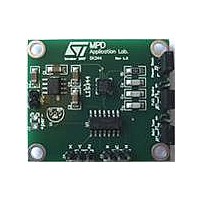STEVAL-MKI109V1 STMicroelectronics, STEVAL-MKI109V1 Datasheet - Page 45

STEVAL-MKI109V1
Manufacturer Part Number
STEVAL-MKI109V1
Description
MOTEHRBOARD MEMS ADAPTER STM32
Manufacturer
STMicroelectronics
Series
MEMSr
Specifications of STEVAL-MKI109V1
Main Purpose
Motherboard; Accelerometer, Gyroscope
Embedded
Yes, MCU, 32-Bit
Utilized Ic / Part
STM32 and MEMS Demo Boards
Primary Attributes
DIL24 Socket for ST MEMS Adapter Boards
Secondary Attributes
3 V on-board linear voltage regulator
Sensing Axis
Triple Axis
Operating Voltage
5 V
Operating Current
0.68 mA
Lead Free Status / RoHS Status
Lead free / RoHS Compliant
For Use With/related Products
LIS344ALH
Other names
497-10682
STM32F102x8, STM32F102xB
Functional EMS (Electromagnetic susceptibility)
While a simple application is executed on the device (toggling 2 LEDs through I/O ports). the
device is stressed by two electromagnetic events until a failure occurs. The failure is
indicated by the LEDs:
●
●
A device reset allows normal operations to be resumed.
The test results are given in
defined in application note AN1709.
Table 29.
Designing hardened software to avoid noise problems
EMC characterization and optimization are performed at component level with a typical
application environment and simplified MCU software. It should be noted that good EMC
performance is highly dependent on the user application and the software in particular.
Therefore it is recommended that the user applies EMC software optimization and pre
qualification tests in relation with the EMC level requested for his application.
Software recommendations: the software flowchart must include the management of
runaway conditions such as:
●
●
●
Prequalification trials
Most of the common failures (unexpected reset and program counter corruption) can be
reproduced by manually forcing a low state on the NRST pin or the Oscillator pins for 1
second. To complete these trials, ESD stress can be applied directly on the device, over the
range of specification values. When unexpected behavior is detected, the software can be
hardened to prevent unrecoverable errors occurring (see application note AN1015).
Electromagnetic Interference (EMI)
The electromagnetic field emitted by the device is monitored while a simple application is
executed (toggling 2 LEDs through the I/O ports). This emission test is compliant with
IEC 61967-2 standard which specifies the test board and the pin loading.
V
V
Symbol
FESD
EFTB
Electrostatic discharge (ESD) (positive and negative) is applied to all device pins until
a functional disturbance occurs. This test is compliant with the IEC 61000-4-2 standard.
FTB: A Burst of Fast Transient voltage (positive and negative) is applied to V
V
compliant with the IEC 61000-4-4 standard.
Corrupted program counter
Unexpected reset
Critical Data corruption (control registers, etc.)
SS
through a 100 pF capacitor, until a functional disturbance occurs. This test is
Voltage limits to be applied on any I/O pin to
induce a functional disturbance
Fast transient voltage burst limits to be
applied through 100 pF on V
to induce a functional disturbance
EMS characteristics
Parameter
Table
Doc ID 15056 Rev 3
29. They are based on the EMS levels and classes
DD
and V
SS
pins
V
f
conforms to IEC 61000-4-2
V
f
conforms to IEC 61000-4-4
HCLK
HCLK
DD
DD
3.3 V, T
3.3 V, T
48 MHz
48 MHz
Conditions
A
Electrical characteristics
A
+25 °C,
+25 °C,
Level/Class
DD
2B
4A
and
45/69



















